Messier 52, Open Star Cluster
Messier 52 is an open star cluster in the constellation Cassiopeia, discovered by Charles Messier in 1774. The distance is 4,600 light-years,
but according to recent data from GAIA a distance of 5,100-5,300 light-years is more likely.
The total brightness of the starry cluster is given as 7.3mag, which corresponds to a luminosity of 2,500 suns at the stated distance. At the
western edge (in the drawing on the right) the 8.3mag bright star "BD +60°2532" can be found, which shines in a soft yellow-orange hue and
is probably a member of Messier 52. The distance could be determined to 5,180 light-years thanks to GAIA. The absolute brightness of the
red giant can be calculated to M=-2.7mag, which corresponds to 1,000 solar luminosities. Altogether the cluster seems to have a total mass
of 1,200 suns. The core radius is given as about 6 light-years, but up to a distance of 42 light-years the stars are gravitationally bound to the
cluster.
The age of Messier 52 is not exactly known. The values vary between 60 million and 150 million years, so the cluster is still quite young.
----------------------------------------------------------------------------------------------------------------------------------------------
In a 20 inch telescope Messier 52 is of course a stunning sight, which is enhanced by a bright, yellowish glowing star at the western edge of the
cluster. At a low magnification of 120x, the cluster appears roundish and only slightly concentrated. This means that the stellar density increases
only slightly towards the center. Nevertheless, it stands out very well from its surroundings.
At high magnifications the sky background becomes pitch black and a lot of faint stars stand out, which were not visible before. At 270x I could
count about 100-110 single stars - but of course this is more an estimate. It always depends on the distance up to which the stars are considered to
belong to the cluster.

